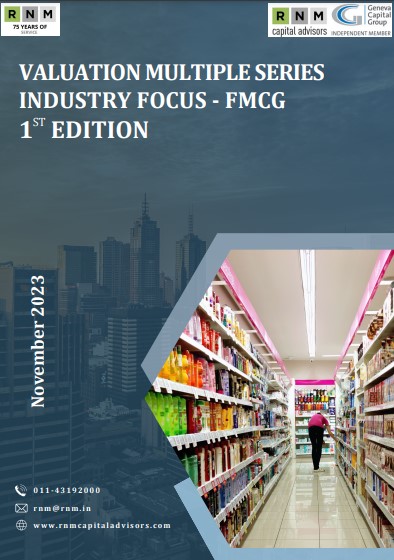
Press Release
RNM Capital Advisors Launches Residential Housing Project in UK
RNM advises Kwality Group on its exit of majority stake in Gaylord Restaurant, London
Research Reports

The diamond, gems, and jewellery industry in India stands as one of the most significant and rapidly expanding sectors of the nation’s economy, deeply embedded in its rich cultural heritage. Renowned for its exceptional artistry, craftsmanship, and innovative designs, India has long been recognized as a global leader in the production, cutting, and trading of diamonds and precious gemstones. This industry not only forms an integral part of India’s
cultural landscape, where jewellery plays a pivotal role in weddings, festivals, and other celebratory occasions, but also holds a strategic position in the global market. This research report aims to provide a detailed analysis of the industry’s financial performance and valuation metrics over the past five years, offering insights into the sector’s evolving landscape.

India’s logistics industry, valued at $250 billion in 2021, is expected to surge to $380 billion by 2025, growing at a robust 10%-12% annually. With e-commerce expansion and technological advancements such as Transportation Management Systems (TMS) and Warehouse Management Systems (WMS), the sector now encompasses end-to-end product planning, last-mile delivery, and predictive analytics. India’s climb to 38th place in the World Bank’s Logistics Performance Index reflects this growth. This report delves into the financial performance, business valuation, and valuation multiples of key players, examining how they have shifted over time

India stands as the world’s second-largest cement producer, contributing over 8% of the global installed capacity. Of this capacity, 98% is controlled by the private sector, with the remaining portion held by the public sector. Given India’s substantial and high- quality limestone reserves, the cement industry holds significant growth potential. In 2023, the market size of the Indian cement industry reached 3.96 billion tonnes and is projected to grow to 5.99 billion tonnes by 2032, reflecting a compounded annual growth rate (CAGR) of 4.7% from 2024 to 2032. This research report aims to provide a detailed analysis of the industry’s financial performance and valuation metrics over the past five years, offering insights into the sector’s evolving landscape.

India is emerging as a powerhouse in the global insurance market, ranking as the 10th largest by total premium volumes and the 2nd largest among all emerging markets,
with an estimated market share of 1.9%. India is poised to lead the G20 nations in insurance sector growth over the next five years until 2028, with a projected real-term expansion of 7.1% in total insurance premiums. The life insurance segment is anticipated to witness a 6.7% growth during this period, driven by escalating demand for term life coverage within the middle-class demographic and the incorporation of Insurtech solutions by the industry.

India is emerging as a powerhouse in the global insurance market, ranking as the 10th largest by total premium volumes and the 2nd largest among all emerging markets,
with an estimated market share of 1.9%. India is poised to lead the G20 nations in insurance sector growth over the next five years until 2028, with a projected real-term expansion of 7.1% in total insurance premiums. The life insurance segment is anticipated to witness a 6.7% growth during this period, driven by escalating demand for term life coverage within the middle-class demographic and the incorporation of Insurtech solutions by the industry.

Indian Railways, often hailed as the lifeline of the nation, stands as the fourth largest and most extensive railway network in the world. Spanning over 68,103 kilometers and connecting remote corners of the country, Indian Railways plays a pivotal role in the socio-economic fabric of India. Established during the British colonial era in the 19th century, it has evolved into a complex network operated by the Indian government through the Ministry of Railways. Renowned for its vast scale, diverse services, and significant cultural impact, Indian Railways remains a symbol of national integration and mobility, serving millions of passengers daily across its myriad routes and services.

The future of the public sector banking industry in India hinges on reforms, technological innovation, and adaptive strategies to address challenges and leverage opportunities. PSBs continue to be integral to the Indian banking landscape, playing a crucial role in financial inclusion, economic development, and nation-building efforts. With concerted efforts from stakeholders, including the government, regulators, and banking institutions, PSBs are poised to navigate challenges and emerge as resilient and customer-centric entities in the evolving banking ecosystem.

Private banks in India hold a prominent position within the nation’s dynamic financial sector, serving as crucial engines of economic growth, promoting financial inclusivity, and facilitating capital accumulation. Over time, these banks have experienced notable expansion and evolution, driven by robust regulatory frameworks, technological advancements, and evolving customer needs. With a steadfast commitment to innovation, operational excellence, and customer satisfaction, Indian private banks have emerged as key catalysts for financial progress and innovation in the region. This research report aims to elucidate the financial performance, and corresponding valuation metrics among private banks over the past five years, providing insights into their dynamic journey within the private banking sector.

The Information Technology (IT) and Information Technology Enabled Services (ITES) sector in India collectively form a dynamic and influential industry that has played a transformative role in the global digital landscape. The IT/ITES sector encompasses a broad range of services, including software development, IT consulting, business process outsourcing (BPO), knowledge process outsourcing (KPO), and other technology-enabled services. India has emerged as a global hub for these services, attracting clients and businesses from around the world. The future of the IT/ITES sector in India looks promising, driven by factors such as increasing digitalization, the adoption of emerging technologies, and the demand for cost-effective and innovative solutions globally. As businesses worldwide continue to embrace digital transformation, India is poised to remain a key player in the global IT/ITES landscape.

The defense sector in India is a critical component of the country’s national security apparatus, playing a pivotal role in safeguarding its borders and ensuring the protection of its citizens. The sector encompasses a wide range of activities, including defense production, research and development, and strategic planning. India’s defense industry has evolved significantly over the years, with a focus on indigenization, technological advancements, and international collaborations. As the country strives to become more self-reliant in defense production, investments in research and development, as well as collaborations with global partners, will be instrumental in ensuring a robust and capable defense apparatus. The evolving geopolitical landscape and security challenges will require the defense sector to remain adaptive and forward-looking in its approach to safeguarding the nation’s interests.

The Fast-Moving Consumer Goods (FMCG) sector in India is one of the largest and most dynamic industries, playing a pivotal role in the country’s economic growth. Characterized by the rapid turnover of products, short shelf life, and relatively low-cost items, the FMCG sector encompasses a wide range of consumer goods such as food and beverages, personal care products, household essentials, and more. This sector is also known as the Consumer Packaged Goods (CPG) industry. India’s FMCG sector has witnessed robust growth over the years, driven by factors such as rising disposable incomes, urbanization, changing consumer lifestyles, and a growing population. The sector is highly competitive, with both domestic and international players vying for market share.

India is the largest global supplier of generic drugs, renowned for its affordable generic medications and vaccines. The Indian Pharmaceutical sector, now ranked third in pharmaceutical production by volume, has transformed into a thriving industry with a (CAGR) of 9.43% over the past nine years. Notable segments within this industry include generic drugs, over-the-counter medicines, bulk drugs, vaccines, contract research and manufacturing, biosimilars, and biologics. Impressively, India boasts the highest count of pharmaceutical manufacturing facilities that adhere to the standards set by the US Food and Drug Administration (USFDA). Furthermore, the country is home to 500 active pharmaceutical ingredients (API) producers, constituting roughly 8% of the global API market.

Healthcare has become one of India’s largest sectors, both in terms of revenue and employment. Healthcare comprises hospitals, medical devices manufacturing, clinical trials, outsourcing, telemedicine, medical tourism and health insurance. The Indian healthcare sector is growing at a brisk pace due to its strengthening coverage, expanding services, and increasing expenditure by the public sector as well private sector. The government, i.e., public healthcare system, comprises limited secondary and tertiary care institutions in key cities and focuses on providing basic healthcare facilities in the form of Primary Healthcare Centers (PHCs) in rural areas whereas the private sector provides majority of secondary, tertiary, and quaternary care institutions with major concentration in metros, tier-I, and tier-II cities.

India’s automotive industry is an important sector driving macroeconomic growth and employment. The industry comprises players of all sizes, from large corporations to micro entities, spread across clusters throughout the country. India has developed expertise in automotive which has helped to boost international demand for Indian automobiles and auto components all over the world. This Report explains how the business valuation, financial performance, and corresponding valuation multiples for companies operating in the Automotive Industry have changed over the last 5 years.

The Automobile Industry of India is one of the most significant economic development drivers and a high participant in global value chains. This Report’s goal is to explain how the business valuation, financial performance, and corresponding valuation multiples for companies operating in the Auto Industry have changed over time.